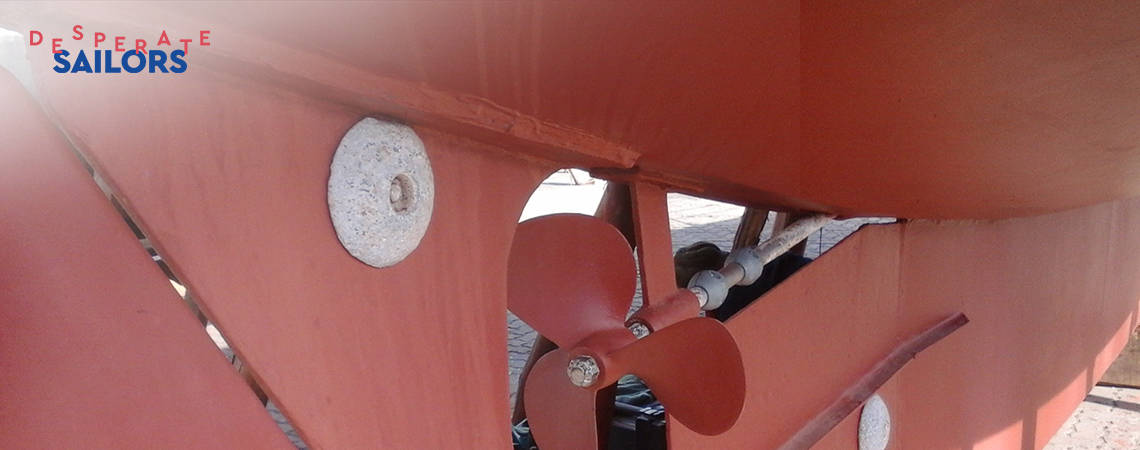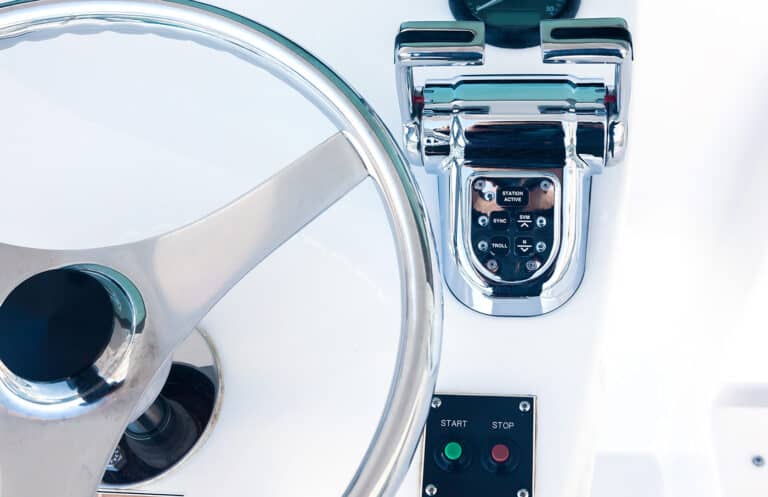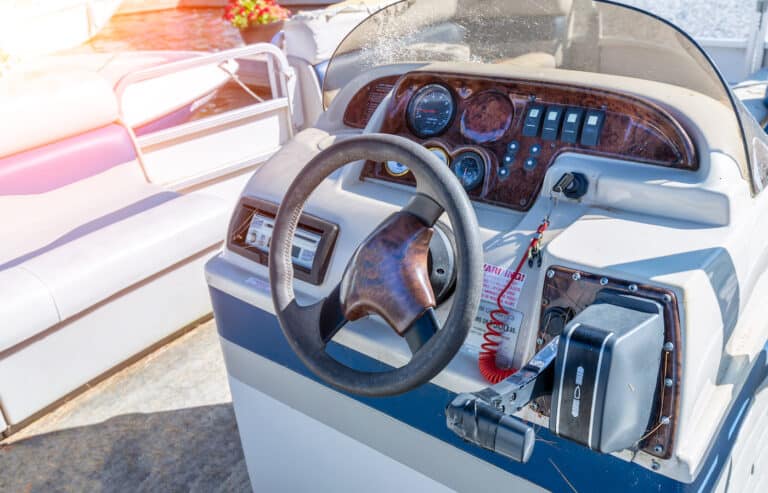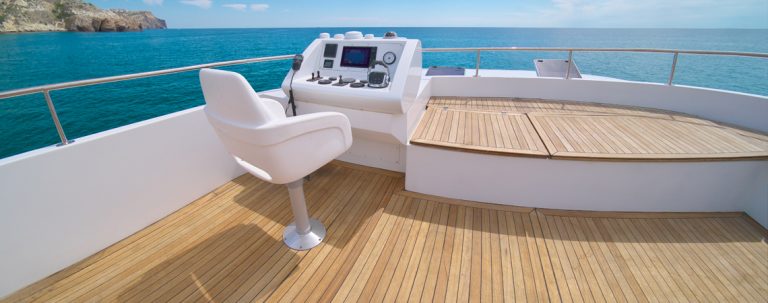Sacrificial anodes are the pieces of metal attached to the main structure to protect it from rust. The idea of how do sacrificial anodes work is used widely, for pipes, monuments, buildings, big ships, and platforms, and as a pleasure boat application.
Sacrificial anodes protect a shaft, a propeller, a keel, a rudder if it is a metal keel or a metal rudder, a swimming platform mechanism, or any other underwater metal part of a boat. Anodes are also effective for the interior metals accumulating humidity, for example, if she is a metal boat.
Let’s find out more…
- How Do Sacrificial Anodes Work?
- What Is Sacrificial Anode Protection on a Boat?
- Do I Need an Anode on My Boat?
- What Is a Sacrificial Anode Made of?
- Anodes for Freshwater vs Anodes for Saltwater
- Anodic Protection of the Aluminum Hull
- How Long Does a Sacrificial Anode Last?
- What Size of Sacrificial Anodes Do I Need?
- How Much Rust May I Allow?
- How Do Sacrificial Anodes Work to the Paint?
- Conclusion on How Do Sacrificial Anodes Work
How Do Sacrificial Anodes Work?
The anodic protection, properly called cathodic protection, is based on the principle of physics where two metals in salt water inevitably form a galvanic battery, then the electric current starts flowing.
Loosely speaking, electrons detach from one metal and fly to another, this courses a weak electric current and results in the loss of material. The part we protect is a cathode, and the piece we sacrifice is an anode.
The loss of material of the sacrificial anodes gives the word “sacrificial” in the description of the method.
What Is Sacrificial Anode Protection on a Boat?
There is a portion of Physics to realize how do sacrificial anodes work. The method is officially called “cathodic protection”, and is more often referred to as sacrificial anodic protection because we put anode to protect the bigger metal construction. Two metals linked together in an electrolyte (like salt water or soil) form an electric system, what we know as a battery, or a galvanic element.
Therefore, an electric current starts running and it results in a subsequent loss of electrons of one of the two metals, then our task is to make a proper metal to decay – this is what sacrificial anodes are for. Such loss of material is defined as corrosion, yet it is hardly a “rust” per se, but as soon as it employs a galvanic system as described it is called galvanic corrosion.
The cathode is a positive element of the system, and in our case, this is what we want to protect. The anode is a negative element of the galvanic system, that we discuss here, and that is what we sacrifice. And we need electrolyte which is water in our case.
Yet another mandatory condition for the galvanic system to start performing is the different electrode potentials of the metals in the system. In case there is no sacrificial anode on the shaft, the system shall be formed by a bronze propeller and a stainless steel shaft. If not that, the bolts may play a role, or anything else. It will be there anyway, and you’d better do the precautions.
Do I Need an Anode on My Boat?
Yes, you need anode protection on your boat.
Regardless of how salty is water where you sail, where your craft is lying: there is water and connected metals there shall be a galvanic system, regardless of anything else.
The math is simple: anodes cost roughly $20 per piece, but they protect a few thousands, if not tens of thousands while doing no harm once correctly installed. That is why you want sacrificial anodes on your boat.
There should not be a whole deep blue sea around to make the galvanic system work. The distilled water is in a lab, but all other cases include fresh water, salt water, and humidity in the air; this provokes what we try to avoid with the sacrificial anodes.
For example, the Statue of Liberty has anodes installed inside of the construction. As soon as the copper “skin” of the Lady is in contact with the iron support structure, she stands not in the water but is exposed to the meteorological events, and she accumulates humidity on her metal parts.
A 20-dollar sacrificial anode saves the whole boat price, an engine of a sailboat, or a priceless historical monument.
Yes, anodes are a genius invention, you need anodes, and not only one.
Sacrificial Anodes for the Shaft and the Propeller
Once you damage a shaft by neglecting anodic protection, that shall result in whole shaft replacement, which is already very close to the end of the world, because a new foreign shaft will hardly fit your engine.
A shaft and an engine come together, and the original shaft fitting the engine is highly recommended. Thus, replacing an engine you’d better do along with the shaft, old boaters say. Replacing the engine because the shaft lacks anodes is the last line in the stupidity test. Not to mention how much time and money you will spend on the deal.
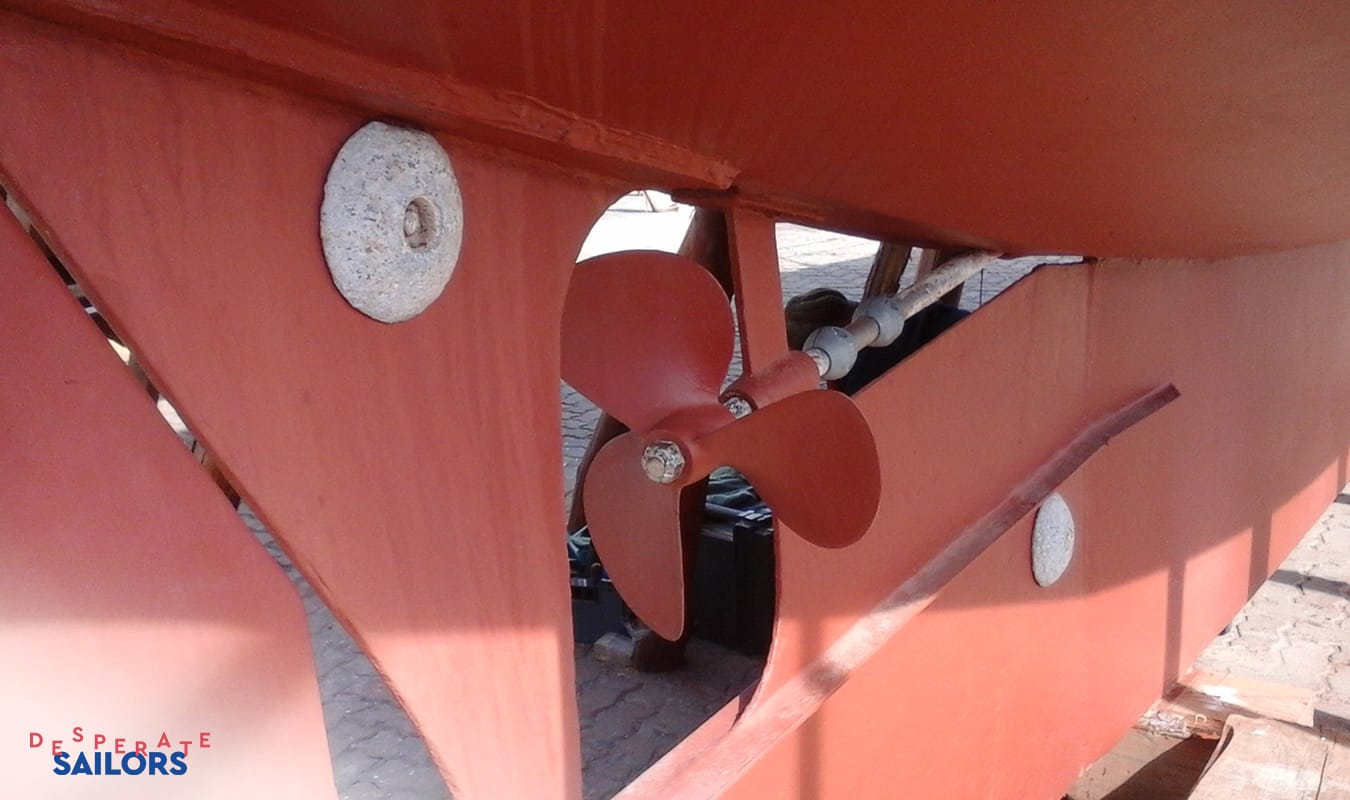
The image above shows that the propeller’s nut is corroded just a little bit. On the shaft, two smaller anodes are fresh, just installed, but the surface of the bigger sacrificial anodes on the keel and rudder is worn-out, yet there is a lot of material yet to decay (after three years of sitting in water).
TIP It is worth checking our sailing terms and phrases explanations.
Sacrificial Anodes for the Metal Keel, Rudder, etc.
Once your boat bears a keel made of iron or other metal or alloy, the loss of the keel is also the last thing you want. Like, you hit something in the water with a weaker keel (which got corroded).
Restoration of a keel is a close to impossible task, you can imagine it is likely more expensive than buying another boat. Losing a keel on the go may end the life of a boat and/or of a crew, in the worst scenario. Yes, that is why we are so paranoid about keel bolts and sealing.
But from the outside, we put anodes upon the keel construction in case the keel is metal. The same for the rudder.
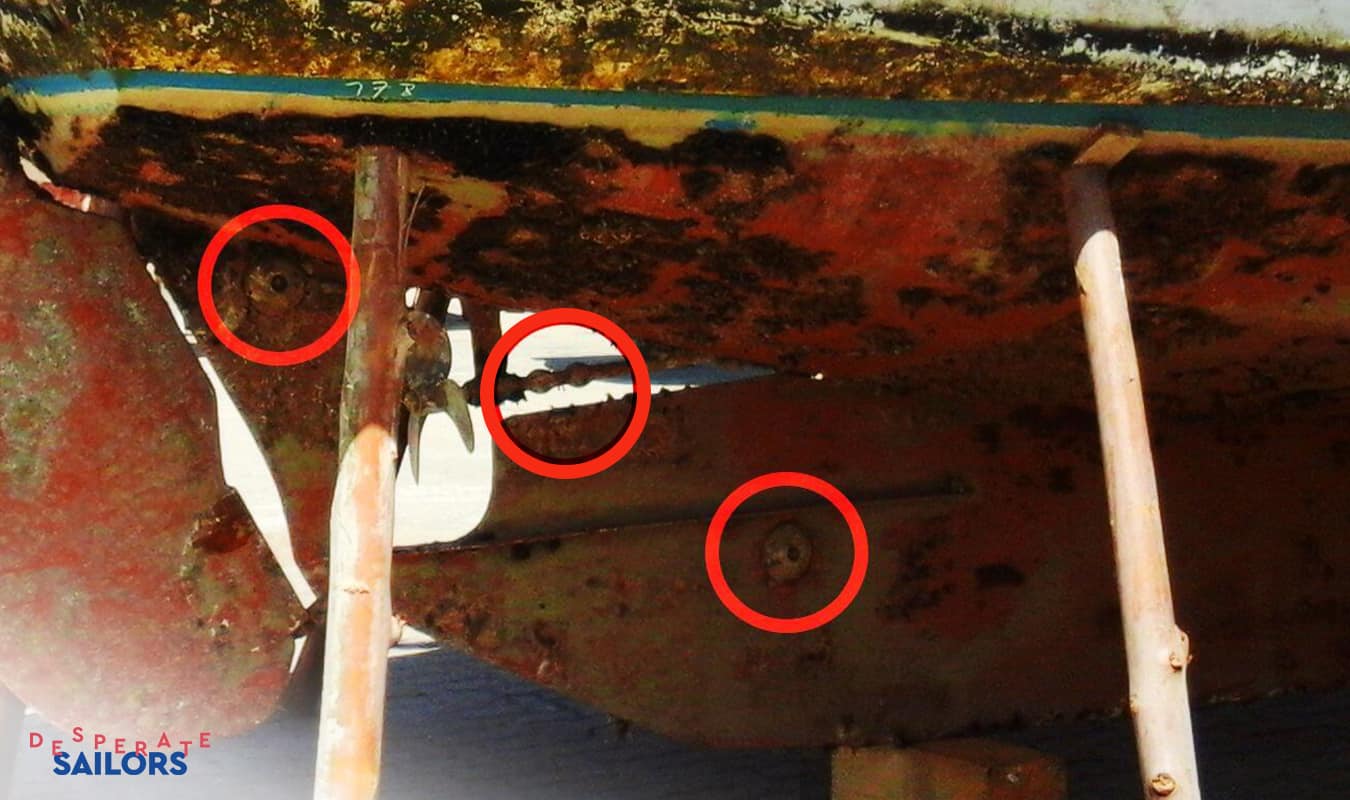
What Is a Sacrificial Anode Made of?
Usually, sacrificial anodes for boats are made of magnesium, aluminum, or zinc.
For freshwater (which may still incite the galvanic current as soon as fresh water is not yet distilled) magnesium is the best, while aluminum anodes are recommended too.
For saltwater – zinc or aluminum are normally used. It seems that aluminum is the universal material for the sacrificial anodes, fitting most boating environments, that is true, but just magnesium performs better in fresh water. The con for the aluminum anodes in freshwater – they may decay much faster.
Aluminum vs Magnesium vs Zinc Anode
The efficiency of sacrificial anodes is measured by the electric potential of the metal, in volts, together with the accumulated size of anodes installed.
The so-called “anodic index” (below) relates to the material anode is made of, and means electric field potential, then the value of potential drop occurring between two elements is expressed in what we call voltage.
Such difference between an anode and a cathode in the sacrificial anodic system is the property of each metal compared to the potential of gold. Gold is at a zero point, and the anodic index of gold is 0 volts.
Anodic Indexes of Sacrificial Anodes
Here we go the numbers to catch the idea about anodic indexes of sacrificial anodes. Remember, that we count anodic index in volts, and we can see from the below list that the usual anode materials are at the very end of this list with the highest voltage. That is why we use them as anodes for they are more active.
| Metal | Anodic index, in Volts |
|---|---|
| Gold | –0,00 (or +0,00 if you wish) |
| Rhodium | –0,05 |
| Silver | –0,15 |
| Steel | from –0,2 to –0,5 |
| Copper | –0,35 |
| Brass and Bronze | –0,40 |
| Iron | –0,5 |
| Chromium | –0,60 |
| Tin | –0,65 |
| Lead | –0,70 |
| Aluminum alloys | from –0,75 to –1,05 |
| Zinc | –1,25 |
| Magnesium | –1,75 |
The materials with a smaller index we call “more anodic”, and the opposite we call “more cathodic”, thus gold is the most cathodic, while magnesium is more anodic than zinc and aluminum. The difference between two metals lying in a range of 0,25–0,50 counts as neutral or relatively safe, therefore you need more anodic sacrificial anodes to protect the construction.
We keep in mind these numbers are reached in a lab, so the real environment may change them, but they are a good reference. The rule of thumb: you do need anodes.
Anodes for Freshwater vs Anodes for Saltwater
Aluminum anodes are proverbial, so to say. If we ask a random guy who has heard nothing but the idea of the cathodic/anodic protection, he will most probably mention aluminum anodes or zinc ones.
Aluminum anodes are universal indeed due to the material’s capacity, which also performs in fresh and salt water.
- Magnesium anodes fit freshwater and protect aluminum.
- Zinc anodes fit saltwater and do not (or loosely) protect aluminum.
- Aluminum anodes are universal, last long, and are the most popular ones.
And, you never use magnesium in salt water. Magnesium anodes are usually used in a low conductivity, like in soils, freshwater, or open-air. Still, in a high conductivity, like salt water, they may decay momentarily, producing too high currents.
Zinc anodes are the best for salt water but have another con: they are cool to pair with an iron structure. However, the ambient temperatures should not be higher than 140 F, which equals 60 C. Once the temperature is reached, the polarization changes, and vice versa – your iron construction protecting the anode, then it’ll be a cathode, and the construction – the anode—a funny trick of nature, no less.
The closer the temperature is to this point, the lower the efficiency zinc anodes deliver. Of course, 140 F is rarely an issue over there below the waterline, but for the things you want to protect on the deck, exposed to sunlight, or too close to the surface, or too close to the engine, you’d better refuse zinc, or take a zinc alloy.
For the reason of idyllic protection, the engineering sciences keep working. You guess it right, people make alloys of all three most popular anodic metals. For example, 6% aluminum, 3% zinc, and 0,15% magnesium demonstrate (–1,6) anodic index, which is lower than magnesium but higher than zinc.
Anodic Protection of the Aluminum Hull
The good question arises once you have an aluminum hull or any aluminum parts of a fair size. Then your hull is already an anode for many metal things around, like a shaft, a propeller, standing rig, safety rails, anchor chain, bolts connecting all these, etc. Except that you keep your hull well coated, you use magnesium anodes to protect it.
- Zinc does not really protect aluminum in freshwater.
- But – in saltwater zinc performs well to protect aluminum.
- Magnesium anodes protect aluminum in freshwater.
- But – magnesium anodes melt down too quickly in saltwater.
Worth to repeat here that for the whole system to function, there must be direct contact between the anode and a protected surface. So your aluminum hull shall not be a huge and expensive sacrificial anode for everything it carries once there is no direct contact. It means: “well-coated and sealed.”
How Long Does a Sacrificial Anode Last?
Sacrificial anodes last for years anyway. For two-three years you are away from any stress, but you keep an eye every time you peek underwater or observe your boat otherwise (e.g. take a look at them when cleaning the bottom of a boat).
Replacement is required when half of an anode is worn out. Usually, we do it every time you haul out the boat annually or bi-annually. Just a reminder, it’s harder to replace than when you are in the water, while the price of anodes is from zero to none. And, you are to use proper anodes. They usually are:
- Magnesium or aluminum for freshwater.
- Zinc or aluminum for saltwater.
Then, the anodes technically form a galvanic battery with an electric current in it, so the capacity is measured in the same units as for batteries: Ampere-hours per kilo. This determines the loss of material. For example, a one-kilo zinc anode of 800 Ah/kg will last 400,000 hours; it’s 45 years if the ambient surrounding allows the development of a current equal, say, to 2 mA.
Also, the energy is required for the self-decaying of anodes, and it means anodes cannot work at 100% efficiency. 90-95% is a good number that can be reached in a lab. The real-life expectation for the hulls and mechanisms of tankers, cargo ships, oil platforms, etc, is somewhat 10-20 years.
We can see that anodes may last really long. Despite the ugly appearance of anodes in the picture, after sitting three years in salt water, we can see that they have lost almost none of their mass!
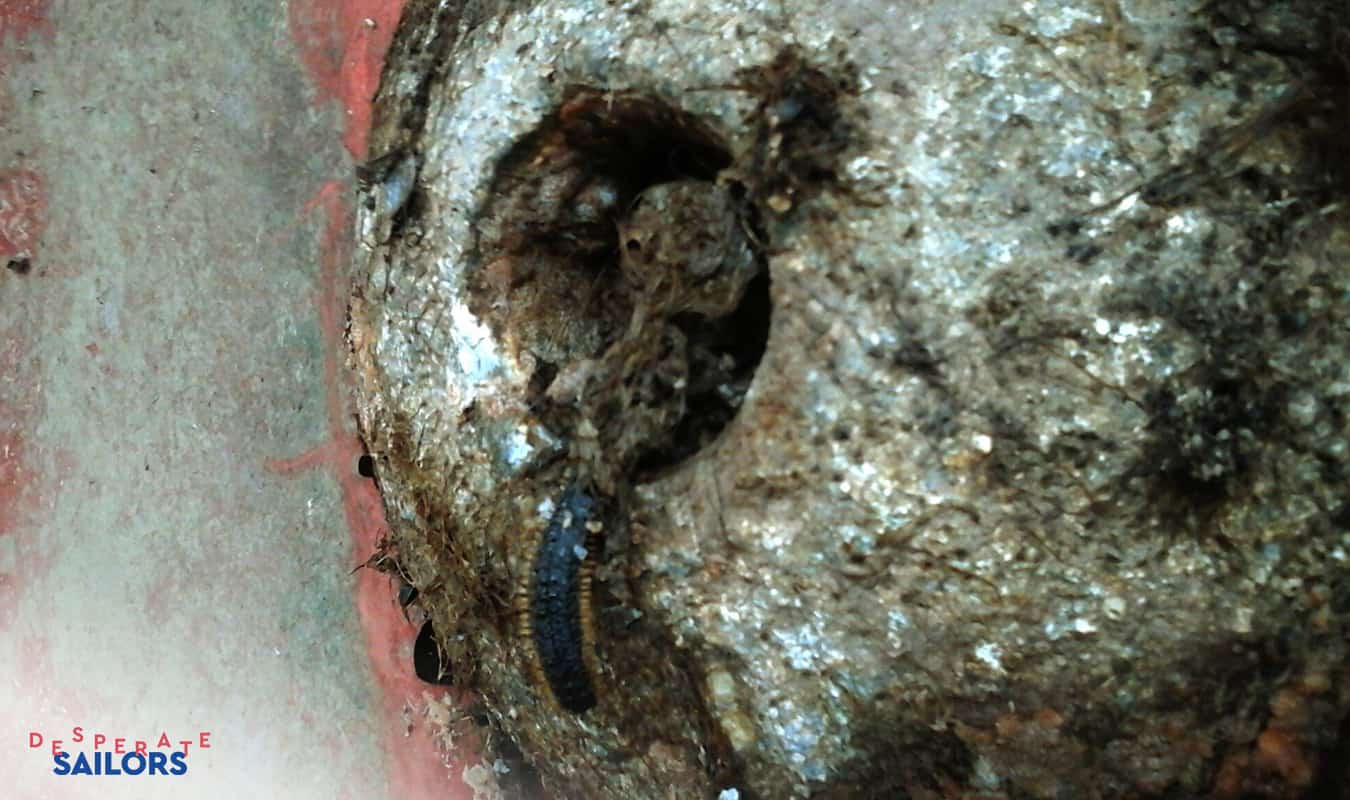
Therefore, we do not need all math calculated every time. Still, all people I know normally keep things simple: detecting the size of an anode out of the experience, watching images on the internet about how other people do, and then adjusting to one’s situation.
What Size of Sacrificial Anodes Do I Need?
You define the size of anodes required to protect your underwater construction empirically; otherwise you may hire a professional to count properly with all formulas and water tests.
Your sacrificial anodes should lose approximately one-half of their original mass before you replace them; either each season or bi-seasonal is a good schedule.
Of course, we suppose a proper size of anodes you use for your environmental conditions. And we just remind here, that the total decay of sacrificial anodes may take several years, but the price of a piece suggests that you change them periodically. No harm for a boat, neither for a budget.
How Much Rust May I Allow?
I once learned a wonderful life hack from an experienced guy. He told me that a 1 mm of metal producing 10 mm of rust – was a rule of thumb!
That translates in the world is not to end if you see a thin rusty layer, visually seeming as if it is a painted layer, say, somewhere on top of a surface of a metal part. Yes, you take immediate action to sleep well, but you are not yet fainted when seeing rust.
Also, rust can develop under the coating; you’ll see somewhat bubbles or thickening on the coated surface as it becomes crusty. In such a case, you use the same rule of “1 mm vs. 10 mm” to estimate the problem, except when the rust leaks down, for example, from a bolt on a vertical surface, you do not know how many “millimeters” have gone.
How Do Sacrificial Anodes Work to the Paint?
Firstly, you do not paint anodes when installing them, as you need to establish a steady contact between the piece anode and itself. Even though the connection is established, do not paint anodes – that is how do sacrificial anodes work.
Secondly, from how do sacrificial anodes work, we know they generate electric currents, therefore, there can be too much anode, generating too many currents. Do not over-anode everything, also called “over-zinc,” as zinc has been historically the most traditional material.
If you over-zinc, then the paint shall flake. It shall start from changing the color, then bulb and flake away. Such happens if you have too much of anode around. Wooden hull may rot from over-zincking.
Conclusion on How Do Sacrificial Anodes Work
Even though there is a curious physical information describing how do sacrificial anodes work, you should not be a physicist to start using the technology. However, the minimum you’d better understand how metals correlate and result in galvanic corrosion: precisely the anodic indexes are for that. Also, you’d better know how long anodes may last for your water.
Well, for the “standard placement”, like a shaft, a keel, or whatever, it’s easy to follow what has been already suggested by the builder. You only learn which type of metal you need for the anodes, and pick ones of a reasonable size.
Apparently – once in a life you may find rust progressing quickly somewhere on the boat where you never have expected it. For example, I once found a decaying iron, where the steel shrouds contacted iron pieces on the deck. In such a case you’d better comprehend a little more about how do the sacrificial anodes work to invent a quick and beautiful solution before an issue may lead to the replacement of structural parts.
Good luck, Captain!
